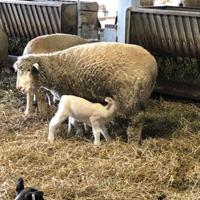
Forage analysis is the cornerstone of developing a feeding program for sheep, goats and cattle. We often focus on moisture, crude protein and fiber measures in assessing the quality and “feed-ability” of the forage.
Further assessment of protein fractions and degradability of forage fiber are measures provided by most laboratories.
Macrominerals, primarily calcium and phosphorus, are reviewed to ensure a proper balance or need for tailored supplementation. Other macrominerals such as magnesium, potassium and sodium are also routinely determined.
The trace minerals are often not measured, as owners assume they are being adequately delivered via their mineral supplement. Most forage laboratories offer a trace mineral analysis package that includes iron, manganese, zinc and copper. The problem here is that most trace minerals interact with others to alter their availability from the diet. Additionally, within the rumen environment, the minerals may be altered and their availability to be absorbed reduced.
One trace mineral of concern here in Pennsylvania is the dietary availability of copper.
Copper plays many important biologic roles in the body, ranging from nerve cell function and cellular respiration to cardiac development, coloration of hair and skin, and immune function. Copper is an essential trace mineral of all animals and needs to be provided in adequate amounts in the diet to prevent a deficiency.
In contrast, most sheep producers are more worried about too much copper in the diet, leading to potential risk for copper toxicosis, since sheep are uniquely sensitive to copper accumulation.
In ruminant animals such as sheep, goats and cattle, copper nutrition is more complex due to a number of potential dietary interactions and rumen alteration limiting availability. The best studied interaction is between copper, molybdenum and sulfur. This is unique to ruminant animals, as the rumen environment and microbes generate a compound from molybdenum and sulfur termed thiomolybdate.
Rumen environment conditions such as pH and dietary amounts of molybdenum and sulfur result in four different forms of thiomolybdates being formed in the rumen. Thiomolybdates bind to the copper ion and prevent it from being absorbed in the small intestine, or bind to copper in proteins, preventing their biologic function.
Smaller thiomolybdate forms can be absorbed while larger molecules cannot and are passed in the feces with the bound copper ion.
Elevated iron in the diet can also compete with copper for absorption and reduce copper availability. Sulfur can directly interact with copper independent of molybdenum. Soluble sulfates in water or the diet are converted to sulfides in the rumen by the microbes, and copper binds to sulfide to form copper sulfide, which is insoluble and unavailable for absorption.
Zinc can also induce an interaction with copper, reducing its availability. When zinc is provided in excessive amounts in the diet, the intestinal cells will synthesize a binding protein, called metallothionein, to prevent excessive zinc uptake. However, this protein also binds copper, preventing its uptake.
From these descriptions, one should recognize the need to better understand the trace mineral content of diets, including forages and supplements. Additionally, waters here in Pennsylvania can contain high concentrations of iron and sulfates, so water analysis should be completed to truly understand the situation relative to copper availability.
If your pastures are located on reclaimed strip-mine areas, drainage may contain up to 2,000 parts per million of soluble sulfates, legally. However, ruminant animals consuming water with over 500 parts per million of sulfates may experience trace mineral issues.
With trace minerals, a clinical deficiency will present with specific physical changes that can be related to the biologic function of the copper-dependent enzyme responsible for that function. For example, clinical copper deficiency often presents with loss of dark coloration in skin or hair. Copper deficient Angus cattle are described as having gray-red goggles around their eyes. Many copper-deficient animals will have lowered red blood cell counts (anemia) due to copper’s role in releasing stored iron for incorporation into new red blood cells.
In our experience, the more common presentation of trace minerals is that of subclinical deficiency. In this situation we do not observe specific physical changes, but more generalized issues that could be attributed to many different causes.
Confirmation of a cause is determined through testing to show low mineral concentrations in blood or liver. Most often, the biologic functions compromised in subclinical deficiencies are the immune response and reproductive function.
What we have seen in diagnosed subclinical copper deficiency situations is a greater prevalence of parasite loads, increased stillborn and neonatal deaths, and poor reproduction.
In these affected flocks and herds, we have not seen the classic clinical deficiency signs. As we pursued the diagnostic process, very low liver copper concentrations on necropsy coupled with inappropriate dietary amounts and relationships among minerals interacting with copper would be identified.
Given these described issues, it is imperative that you include trace mineral analysis when completing your feed testing. Determination of sulfur and molybdenum are optional tests that need to be requested in addition to the trace mineral analysis.
In reviewing forage test results from Pennsylvania, over 33% of forages had elevated molybdenum concentrations that would potentially lead to copper issues.
Using this information, we want to develop a diet that has no less than a 6:1 ration between copper and molybdenum. Ratios below 4:1 are consistent with inducing copper deficiency. Larger ratios such as 12:1 or higher could be indicative of potential copper toxicosis.
Unfortunately, there are no definitive recommendations for dietary ratio between copper and sulfur. Dietary sulfur should be less than 0.3% of dry matter.
Remember, although ratios are important criteria, the total intake of copper is also important to assess. Work with your nutritionist to prevent copper-related issues.
